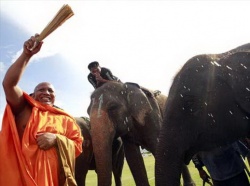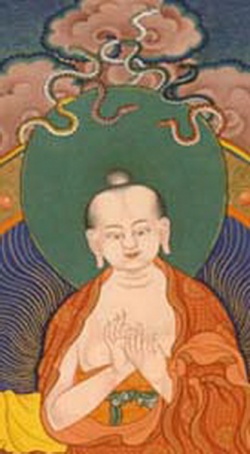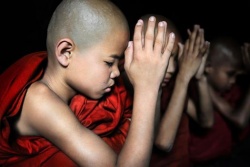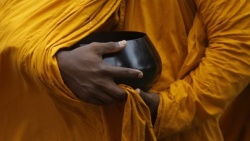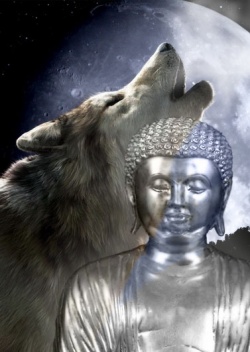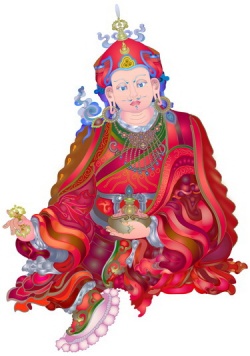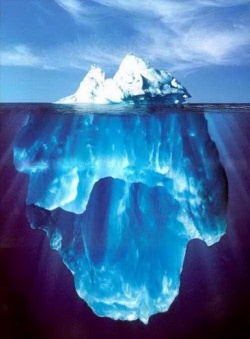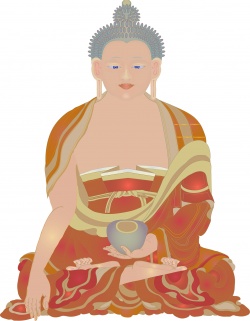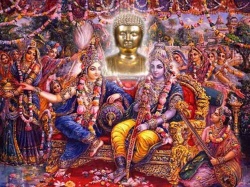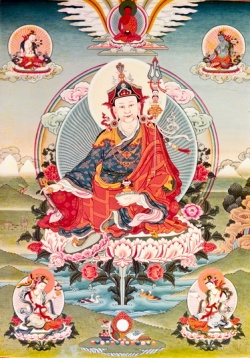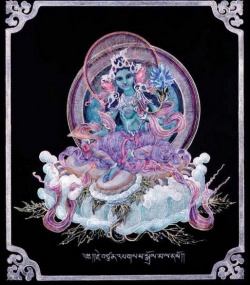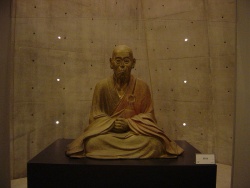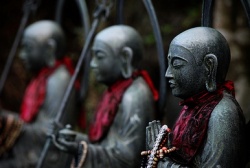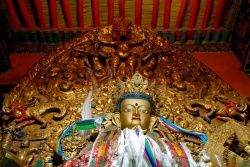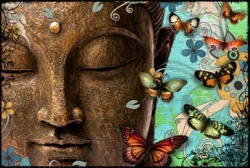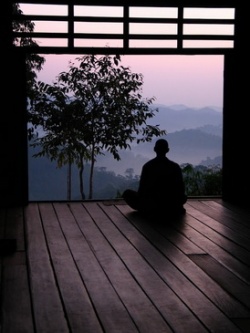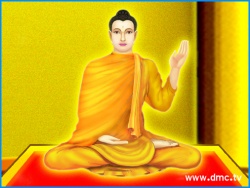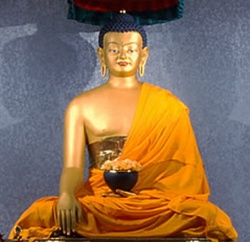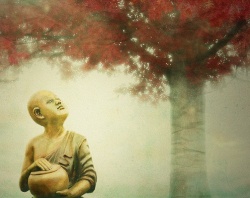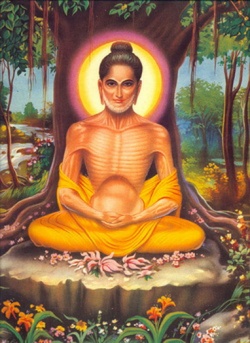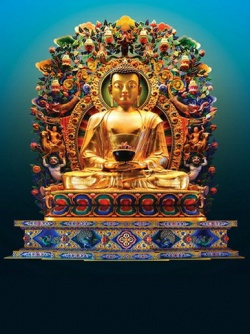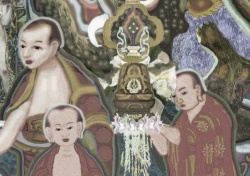Meditation
Meditation. To sit on the cushion is to be enlightened. Zazen is a cornerstone and foundation to our practice and development. We set aside time each morning and evening to sit with ourselves in the Zendo. Lighting the candle, the incense, and reciting the Wisdom Heart Sutra, we renew our vows and bring ourselves to the practice of studying ourselves. As the self drops away and we are able to see clearly our true nature, we see the purity and wisdom of the Dharma teachings. Getting up from the cushion, we know that we are taking with us a profound grounding and truth that we can share with others. We share this without a word, just as the Buddha shared with Mahakashyapa, the complete and total understanding with a flower in his fingers.
meditation
禅・禅定 (Skt dhyana; Pali jhana; Jpn zen or zenjo )
The practice of focusing the mind on one point in order to purify the spirit, eradicate illusions, and perceive the truth. Meditation was practiced widely in India before Shakyamuni, and was later incorporated into Buddhism, which developed its own forms and approaches.
Mahayana Buddhism, dhyana, meaning meditation, is the fifth of the six paramitas, six practices required of Mahayana bodhisattvas. In China, T'ient'ai (538-597) established a system of meditative practice he named "concentration and insight." China also saw the appearance of the Ch'an, or Zen, school, which places primary emphasis on meditation as the practice for attaining enlightenment. See also seated meditation; Zen school.
Meditation is a practice in which an individual trains the mind or induces a mode of Consciousness, either to realize some benefit or as an end in itself.
The term meditation refers to a broad variety of practices (much like the term sports) that includes techniques designed to promote relaxation, build internal energy (chi, ki, prana, etc.) and develop Compassion,Love, Patience, Generosity and Forgiveness. A particularly ambitious Form of meditation aims at effortlessly sustained single-pointed Concentration single-pointed analysis, meant to enable its practitioner to enjoy an indestructible sense of well-being while engaging in any Life activity.
Meditation often involves an internal effort to self-regulate the mind in some way. Meditation can help clear the mind and ease many health issues, such as high blood pressure,depression, and anxiety to name a few (Yoga Journal). It may be done sitting, or in an active way, for instance Buddhist monks involve awareness in their day-to-day activities as a Form of mind-training. Prayer beads or other ritual objects are commonly used during meditation in order to keep track of or remind the practitioner about some aspect of the training.
Meditation may involve generating an emotional state for the purpose of analyzing that state — such as Anger, hatred, etc. — or cultivating particular mental response to various phenomena, such as Compassion. The term "meditation" can refer to the state itself, as well as to practices or techniques employed to cultivate the state. In brief, there are dozens of specific styles of meditation practice;the word meditation may carry different meanings in different contexts. Meditation has been practiced since antiquity as a component of numerous religious traditions and beliefs.
Etymology
The English meditation is derived from the Latin meditatio, from a verb meditari, meaning "to think, contemplate, devise, ponder".
In the Old Testament, hāgâ (Hebrew: הגה) means to sigh or murmur, and also, to meditate. When the Hebrew Bible was translated into Greek, hāgâ became the Greek melete. The Latin Bible then translated hāgâ/melete into meditatio.The use of the term meditatio as part of a formal, stepwise process of meditation goes back to the 12th-century Monk Guigo II.
The Tibetan word for meditation "Gom" means "to become familiar with one's Self" and has the strong implication of training the mind to be familiar with states that are beneficial: Concentration, Compassion, correct understanding, Patience, humility, perseverance, etc.
Apart from its historical usage, the term meditation was introduced as a translation for Eastern spiritual practices, referred to as ([[[Dhyāna]])] in Buddhism and in Hinduism, which comes from the Sanskrit root dhyai, meaning to contemplate or meditate.
The term "meditation" in English may also refer to practices from Islamic Sufism, or other traditions such as Jewish Kabbalah and Christian Hesychasm.
An edited book about "meditation" published in 2003, for example, included chapter contributions by authors describing Hindu, Buddhist, Taoist, Jewish, Christian and Islamic traditions. Scholars have noted that "the term 'meditation' as it has entered contemporary usage" is parallel to the term "contemplation" in Christianity.
History
The history of meditation is intimately bound up with the religious context within which it was practiced. Even in prehistoric times civilizations used repetitive, rhythmic chants and offerings to appease the gods.
Some authors have even suggested the hypothesis that the emergence of the capacity for focused attention, an element of many methods of meditation, may have contributed to the final phases of human biological Evolution.Some of the earliest references to meditation are found in the Hindu Vedas.
Wilson translates the most famous Vedic Mantra 'Gayatri' thus : "We meditate on that desirable Light of the divine Savitri, who influences our piuous rites" (Rgveda : Mandala-3, Sukta-62, Rcha-10).
Around the 6th to 5th centuries BCE, other forms of meditation developed in Taoist China and Buddhist India.
In the west, by 20 BCE Philo of Alexandria had written on some Form of "spiritual exercises" involving attention (prosoche) and Concentration and by the 3rd century Plotinus had developed meditative techniques.
The Pāli Canon, which dates to 1st century BCE considers Indian Buddhist meditation as a step towards salvation. By the time Buddhism was spreading in China, the Vimalakirti Sutra which dates to 100 CE included a number of passages on meditation, clearly pointing to Zen. The [[Silk Road]] transmission of Buddhism introduced meditation to other Asian countries, and in 653 the first meditation hall was opened in Singapore. Returning from China around 1227, Dōgen wrote the instructions for Zazen.
The Islamic practice of Dhikr had involved the repetition of the 99 Names of God since the 8th or 9th century. By the 12th century, the practice of Sufism included specific meditative techniques, and its followers practiced breathing controls and the repetition of holy words. Interactions with Indians or the Sufis may have influenced the Eastern Christian meditation approach to hesychasm, but this can not be proved.Between the 10th and 14th centuries, hesychasm was developed, particularly on Mount Athos in Greece, and involves the repetition of the Jesus prayer.
Buddhist monk Meditating in a Waterfall Setting
Western Christian meditation contrasts with most other approaches in that it does not involve the repetition of any phrase or action and requires no specific posture. Western Christian meditation progressed from the 6th century practice of Bible reading among Benedictine monks called Lectio Divina, i.e. divine reading. Its four formal steps as a "ladder" were defined by the Monk Guigo II in the 12th century with the Latin terms lectio, meditatio, oratio, and contemplatio (i.e. read, ponder, pray, contemplate). Western Christian meditation was further developed by saints such as Ignatius of Loyola and Teresa of Avila in the 16th century.
By the 18th century, the study of Buddhism in the West was a topic for intellectuals. The Philosopher Schopenhauer discussed it, and Voltaire asked for toleration towards Buddhists. The first English translation of the Tibetan Book of the Dead was published in 1927.
Secular forms of meditation were introduced in India in the 1950s as a Westernized Form of Hindu meditative techniques and arrived in the United States and Europe in the 1960s. Rather than focusing on spiritual growth, secular meditation emphasizes stress reduction, relaxation and self-improvement.
Both spiritual and secular forms of meditation have been subjects of scientific analyses. Research on meditation began in 1931, with scientific research increasing dramatically during the 1970s and 1980s. Since the beginning of the '70s more than a thousand studies of meditation in English-Language have been reported.However, after 60 years of scientific study, the exact mechanism at work in meditation remains unclear.
Modern definitions and Western models
Definitions and scope
Definitions or Characterizations of Meditation:
Examples from Prominent Reviews*
Definition / Characterization
Review
•"editation refers to a family of self-regulation practices that focus on training attention and awareness in order to bring mental processes under greater voluntary control and thereby foster general mental well-being and development and/or specific capacities such as calm, clarity, and Concentration":228-9 Walsh & Shapiro (2006)
•"editation is used to describe practices that self-regulate the Body and mind, thereby affecting mental events by engaging a specific attentional set.... regulation of attention is the central commonality across the many divergent methods":180 Cahn & Polich (2006)
•"We define meditation... as a stylized mental technique... repetitively practiced for the purpose of attaining a subjective experience that is frequently described as very restful, silent, and of heightened alertness, often characterized as blissful":415 Jevning et al. (1992)
•"the need for the meditator to retrain his attention, whether through Concentration or Mindfulness, is the single invariant ingredient in... every meditation system":107 Goleman (1988)
- Influential reviews (cited >50 times in PsycINFO),
encompassing multiple methods of meditation.
As early as 1971, Claudio Naranjo noted that "The word 'meditation' has been used to designate a variety of practices that differ enough from one another so that we may find trouble in defining what meditation is.":6 There remains no definition of necessary and sufficient criteria for meditation that has achieved universal or widespread acceptance within the modern scientific community, as one study recently noted a "persistent lack of consensus in the literature" and a "seeming intractability of defining meditation".:135
In popular usage, the word "meditation" and the phrase "meditative practice" are often used imprecisely to designate broadly similar practices, or sets of practices, that are found across many cultures and traditions.
Some of the difficulty in precisely defining meditation has been the need to recognize the particularities of the many various traditions. There may be differences between the theories of one tradition of meditation as to what it means to practice meditation.
The differences between multiple various traditions, which have grown up a great distance apart from each other, may be even starker. The defining of what 'meditation' is has caused difficulties for modern scientists.
Scientific reviews have proposed that researchers attempt to more clearly define the type of meditation being practiced in order that the results of their studies be made clearer.:499 Taylor noted that to refer only to meditation from a particular Faith (e.g., "Hindu" or "Buddhist")
is not enough, since the cultural traditions from which a particular kind of meditation comes are quite different and even within a single tradition differ in complex ways. The specific name of a school of thought or a teacher or the title of a specific text is often quite important for identifying a particular type of meditation.:2
Patañjali Statue (traditional Form indicating Kundalini or incarnation of Shesha)
The table shows several definitions of meditation that have been used by influential modern reviews of research on meditation across multiple traditions. Within a specific context, more precise meanings are not uncommonly given the word "meditation."
For example, 'meditation', is sometimes the translation of meditatio in Latin, which is the third of four steps of Lectio Divina, an ancient Form of Christian prayer. 'Meditation' may also refer to the second of the three steps of Yoga in Patanjali's Yoga Sutras, a step called Dhyāna in Sanskrit. Meditation may refer to a mental or spiritual state that may be attained by such practices, and may also refer to the practice of that state.
This article mainly focuses on meditation in the broad sense of a type of discipline, found in various forms in many cultures, by which the practitioner attempts to get beyond the reflexive, "thinking" mind(sometimes called "discursive thinking" or "logic") into a deeper, more devout, or more relaxed state. The terms "meditative practice" and "meditation" are mostly used here in this broad sense.
However, usage may vary somewhat by context — readers should be aware that in quotations, or in discussions of particular traditions, more specialized meanings of "meditation" may sometimes be used (with meanings made clear by context whenever possible).
===Western typologies===
Ornstein noted that "most techniques of meditation do not exist as solitary practices but are only artificially separable from an entire system of practice and belief".:143 This means that, for instance, while monks engage in meditation as a part of their everyday lives, they also engage the codified rules and live together in monasteries in specific cultural settings, that go along with their meditative practices.
These meditative practices sometimes have similarities (often noticed by Westerners), for instance Concentration on the Breath is practiced in Zen, Tibetan and Theravadan contexts, and these similarities or 'typologies' are noted here.
Progress on the "intractable" problem of defining meditation was attempted by a recent study of views common to seven experts trained in diverse but empirically highly studied (clinical or Eastern-derived) forms of meditation. The study identified "three main criteria... as essential to any meditation practice: the use of a defined technique, logic relaxation, and a self-induced state/mode.
Other criteria deemed important [but not essential) involve a state of psychophysical relaxation, the use of a self-focus skill or anchor, the presence of a state of suspension of logical thought processes, a religious/spiritual/philosophical context, or a state of mental silence".:135
However, the study cautioned that "It is plausible that meditation is best thought of as a natural category of techniques best captured by 'family resemblances'... or by the related prototype model of concepts".
In modern psychological research, meditation has been defined and characterized in a variety of ways; many of these emphasize the role of attention.
In the West, meditation is sometimes thought of in two broad categories: concentrative meditation and Mindfulness meditation. These two categories are discussed in the following two paragraphs, with concentrative meditation being used interchangeably with focused attention and Mindfulness meditation being used interchangeably with open monitoring,
direction of mental attention... A practitioner can focus intensively on one particular object (so-called concentrative meditation), on all mental events that enter the field of awareness (so-called Mindfulness meditation), or both specific focal points and the field of awareness:130
"One style, Focused Attention (FA) meditation, entails the voluntary focusing of attention on a chosen object. The other style, Open Monitoring (OM) meditation, involves non-reactive monitoring of the content of experience from moment to moment.
Other typologies have also been proposed,and some techniques shift among major categories.
Evidence from neuroimaging studies suggests that the categories of meditation, defined by how they direct attention, appear to generate different brainwave patterns. Evidence also suggests that using different focus objects during meditation may generate different brainwave patterns.
Religious and spiritual meditation
===Bahá'í Faith===
In the teachings of the Bahá'í Faith meditation, along with prayer, is one of the primary tools for spiritual development, and it mainly refers to one's reflection on the words of God. While prayer and meditation are linked where meditation happens generally in a prayerful attitude, prayer is seen specifically as turning toward God, and meditation is seen as a communion with one's self where one focuses on the divine.
The Bahá'í teachings note that the purpose of meditation is to strengthen one's understanding of the words of God, and to make one's soul more susceptible to their potentially transformative Power, and that both prayer and meditation are needed to bring about and to maintain a spiritual communion with God.
Bahá'u'lláh, the founder of the religion, never specified any particular Form of meditation, and thus each person is free to choose their own Form. However, he specifically did state that Bahá'ís should read a passage of the Bahá'í writings twice a day, once in the morning, and once in the evening, and meditate on it. He also encouraged people to reflect on one's actions and worth at the end of each day. The Nineteen Day Fast, a nineteen-day period of the year, during which Bahá'ís adhere to a sunrise-to-sunset fast, is also seen as meditative, where Bahá'ís must meditate and pray to reinvigorate their spiritual forces
.
Buddhism
===Dynamic tranquility: The Buddha in contemplation===
Buddhist meditation refers to the meditative practices associated with the religion and philosophy of Buddhism. Core meditation techniques have been preserved in ancient Buddhist texts and have proliferated and diversified through teacher-student transmissions. Buddhists pursue meditation as part of the path toward Enlightenment and Nirvana.
The closest words for meditation in the classical languages of Buddhism are bhāvanā, Jhāna/Dhyāna, and vipassana. According to Manmatha Nath Dutt, there is hardly any difference between mainstream Hinduism's Dhyana, Dharana and Samadhi with the Buddhist Dhyana, Bhavana, Samadhi, especially as both require following The Precepts (nayas and niyamas.)
Buddhist meditation techniques have become increasingly popular in the wider World, with many non-Buddhists taking them up for a variety of reasons. There is considerable homogeneity across meditative practices — such as Breath meditation and various recollections (anussati) — that are used across Buddhist schools, as well as significant diversity.
In the Theravāda tradition alone, there are over fifty methods for developing Mindfulness and forty for developing Concentration, while in the Tibetan tradition there are thousands of visualization meditations. Most classical and contemporary Buddhist meditation guides are school-specific.
The Buddha is said to have identified two paramount mental qualities that arise from wholesome meditative practice:
"serenity" or "tranquillity" (Pali: Samatha) which steadies, composes, unifies and concentrates the mind;
"insight" (Pali: vipassana) which enables one to see, explore and discern "formations" (conditioned phenomena based on The five aggregates).
Through the meditative development of serenity, one is able to release obscuring hindrances; and it is, with the release of the hindrances, through the meditative development of insight that one gains liberating Wisdom.
Christianity
A strong believer in Christian meditation, Saint Padre Pio stated: "Through the study of Books one seeks God; by meditation one finds him".
Main articles: Christian meditation, Aspects of Christian meditation, Contemplative prayer, Hesychasm, and Theoria
Christian Meditation is a term for Form of prayer in which a structured attempt is made to get in touch with and deliberately reflect upon the revelations of God. The word meditation comes from the Latin word meditari, which means to concentrate.
Christian meditation is the process of deliberately focusing on specific thoughts (e.g. a biblical scene involving Jesus and the Virgin Mary) and reflecting on their meaning in the context of the Love of God.
Christian meditation contrasts with cosmic styles of eastern meditation as radically as the portrayal of God the Father in the Bible contrasts with discussions of Krishna or Brahman in Indian teachings.
Unlike eastern meditations, most styles of Christian meditations do not rely on the repeated use of mantras, but are intended to stimulate thought and deepen meaning. Christian meditation aims to heighten the personal relationship based on the Love of God that marks Christian communion.
In Aspects of Christian meditation, the Catholic Church warned of potential incompatibilities in mixing Christian and eastern styles of meditation. In 2003, in A Christian reflection on the New Age the Vatican announced that the "Church avoids any concept that is close to those of the New Age".
Christian meditation is sometimes taken to mean the middle level in a broad three stage characterization of prayer: it then involves more reflection than first level vocal prayer, but is more structured than the multiple layers of contemplation in Christianity.
Hinduism
There are many schools and styles of meditation within Hinduism. Yoga is generally done to prepare one for meditation, and meditation is done to realize union of one's self, one's Atman, with the omnipresent and non-dual Brahman. This experience is referred to as moksha by Hindus, and is similar to the concept of Nirvana in Buddhism.
The earliest clear references to meditation in Hindu literature are in the middle Upanishads and the Mahabharata, which includes the Bhagavad Gita. According to Gavin Flood, the earlier Brihadaranyaka Upanishad refers to meditation when it states that "having becoming calm and concentrated, one perceives the self (ātman) within oneself"
Within Patañjali's ashtanga yoga practice there are eight limbs leading to moksha.
These are ethical discipline (yamas), rules (niyamas), physical postures (asanas), Breath control (pranayama), withdrawal from the senses (pratyahara), one-pointedness of mind (dharana), meditation (Dhyana), and finally Samadhi, which is often described as the union of the Self (Atman) with the omnipresent (Brahman), and is the ultimate aim of all Hindu yogis.
Meditation in Hinduism is not confined to any school or sect and has expanded beyond Hinduism to the West
The influential modern proponent of Hinduism who first introduced Eastern philosophy to the West in the late 19th century, Swami Vivekananda, describes meditation as follows:
Meditation has been laid stress upon by all religions.
The meditative state of mind is declared by the Yogis to be the highest state in which the mind exists. When the mind is studying the external object, it gets identified with it, loses itself. To use the simile of the old Indian Philosopher: the soul of man is like a piece of crystal, but it takes the colour of whatever is near it. Whatever the soul touches ... it has to take its colour. That is the difficulty. That constitutes the bondage.
Islam
===Dhikr===
Remembrance of God in Islam, which is known by the concept Dhikr is interpreted in different meditative techniques in Sufism or Islamic mysticism. This became one of the essential elements of Sufism as it was systematized traditionally.
It is juxtaposed with fikr (thinking) which leads to Knowledge. By the 12th century, the practice of Sufism included specific meditative techniques, and its followers practiced breathing controls and the repetition of holy words.
Numerous Sufi traditions place emphasis upon a meditative procedure which comes from the cognitive aspect to one of the two principal approaches to be found in the Buddhist traditions: that of the Concentration technique, involving high-intensity and sharply focused introspection. In the Oveyssi-Shahmaghsoudi Sufi order, for example, this is particularly evident, where muraqaba takes the Form of tamarkoz, the latter being a Persian term that means Concentration. Meditative quiescence is said to have a quality of Healing, and—in contemporary terminology—enhancing creativity.
Tafakkur or tadabbur in Sufism literally means reflection upon the Universe: this is considered to permit access to a Form of cognitive and emotional development that can emanate only from the higher level, i.e. from God. The sensation of receiving divine inspiration awakens and liberates both Heart and intellect, permitting such inner growth that the apparently mundane actually takes on the quality of the infinite. Muslim teachings embrace Life as a test of one's submission to God.
Meditation in the Sufi traditions is largely based on a spectrum of mystical exercises, varying from one lineage to another. Such techniques, particularly the more audacious, can be, and often have been down the ages, a source of controversy among scholars. One broad group of ulema, followers of the great Al-Ghazzali, for example, have in general been open to such techniques and forms of devotion.
===Jainism===
In Jainism, meditation has been a core spiritual practice, one that Jains believe people have undertaken since the teaching of the Tirthankara, Rishabha. All the twenty-four Tirthankaras practiced deep meditation and attained Enlightenment. They are all shown in meditative postures in the images or idols. Mahavira practiced deep meditation for twelve years and attained Enlightenment.
The Acaranga Sutra dating to 500 BC, addresses the meditation system of Jainism in detail. Acharya Bhadrabahu of the 4th century BC practiced deep Mahaprana meditation for twelve years. Kundakunda of 1st century BCE, opened new dimensions of meditation in Jain tradition through his Books Samayasāra, Pravachansar and others.
Jain meditation and spiritual practices system were referred to as salvation-path. It has three important parts called the Ratnatraya "Three Jewels": right Perception and Faith, right Knowledge and right conduct.
Meditation in Jainism aims at realizing the self, attaining salvation, take the soul to complete freedom. It aims to reach and to remain in the pure state of soul which is believed to be pure Consciousness, beyond any Attachment or aversion. The practitioner strives to be just a knower-seer (Gyata-Drashta). Jain meditation can be broadly categorized to Dharmya Dhyana and Shukla Dhyana.
There exists a number of meditation techniques such as pindāstha-Dhyāna, padāstha-Dhyāna, rūpāstha-Dhyāna, rūpātita-Dhyāna, savīrya-Dhyāna, etc. In padāstha Dhyāna one focuses on Mantra.A Mantra could be either a combination of core letters or words on deity or themes.
There is a rich tradition of Mantra in Jainism. All Jain followers irrespective of their sect, whether Digambara or Svetambara, practice Mantra. Mantra Chanting is an important part of daily lives of Jain monks and followers.
Mantra Chanting can be done either loudly or silently in mind. Yogasana and Pranayama has been an important practice undertaken since ages. Pranayama – breathing exercises – are performed to strengthen the five Pranas or vital energy.
Yogasana and Pranayama balances the functioning of neuro-endocrine system of Body and helps in achieving good physical, mental and emotional health.
Contemplation is a very old and important meditation technique. The practitioner meditates deeply on subtle facts. In agnya vichāya, one contemplates on seven facts — Life and non-Life, the inflow, bondage, stoppage and removal of karmas, and the final accomplishment of liberation. In apaya vichāya, one contemplates on the incorrect insights one indulges, which eventually develops right insight. In Vipaka vichāya, one reflects on the eight causes or basic types of Karma. In sansathan vichāya, one thinks about the vastness of the Universe and the loneliness of the soul.
Acharya Mahapragya formulated Preksha meditation in the 1970s and presented a well-organised system of meditation. Asana and Pranayama, meditation, contemplation, Mantra and therapy are its integral parts. Numerous Preksha meditation centers came into existence around the World and numerous meditations camps are being organized to impart training in it.
===Judaism===
There is evidence that Judaism has had meditative practices that go back thousands of years. For instance, in the Torah, the Patriarch Isaac is described as going "לשוח" (lasuach) in the field—a term understood by all commentators as some type of meditative practice (Genesis 24:63).
Similarly, there are indications throughout the Tanach (the Hebrew Bible) that meditation was used by the prophets. In the Old Testament, there are two Hebrew words for meditation: hāgâ (Hebrew: הגה), which means to sigh or murmur, but also to meditate, and sîḥâ (Hebrew: שיחה), which means to muse, or rehearse in one's mind.
The Jewish mystical tradition, Kabbalah, is inherently a meditative field of study. Traditionally, Kabbalah is only taught to Jews over the age of forty in Ashkenaz, though training begins at 13 in Sephardic and Mizrahi communities.
The Talmud refers to the advantage of the scholar over the prophet, as his understanding takes on intellectual, conceptual Form, that deepens mental grasp, and can be communicated to others. The advantage of the prophet over the scholar is in the transcendence of their intuitive vision. The ideal illumination is achieved when the insights of mystical revelation are brought into conceptual structures.
For example, Isaac Luria revealed new doctrines of Kabbalah in the 16th Century, that revolutionised and reordered its teachings into a new system. However, he did not write down his teachings, which were recounted and interpreted instead by his close circle of disciples. After a mystical encounter, called in Kabbalistic tradition an "elevation of the soul" into the spiritual realms, Isaac Luria said that it would take 70 years to explain all that he had experienced.
As Kabbalah evolved its teachings took on successively greater conceptual Form and philosophical system. Nonetheless, as is implied by the name of Kabbalah, which means "to receive", its exponents see that for the student to understand its teachings requires a spiritual intuitive reception that illuminates and personalises the intellectual structures.
Corresponding to the learning of Kabbalah are its traditional meditative practices, as for the Kabbalist, the ultimate purpose of its study is to understand and cleave to the Divine. Classic methods include the mental visualisation of the supernal realms the soul navigates through to achieve certain ends. One of the best known types of meditation in early Jewish mysticism was the work of the Merkabah, from the root /R-K-B/ meaning "chariot" (of God).
In modern Jewish practice, one of the best known meditative practices is called "hitbodedut" (התבודדות, alternatively transliterated as "hisbodedus"), and is explained in Kabbalistic, Hasidic, and Mussar writings, especially the Hasidic method of Rabbi Nachman of Breslav. The word derives from the Hebrew word "boded" (בודד), meaning the state of being alone.
Another Hasidic system is the Habad method of "hisbonenus", related to the Sephirah of "Binah", Hebrew for understanding. This practice is the analytical reflective process of making oneself understand a mystical concept well, that follows and internalises its study in Hasidic writings.
Magic-Based Religions
Religions and religious movements which use magic, such as Wicca, Neopaganism, occultism etc, often require their adherents to meditate as a preliminary to magical work. This is because magic is often thought to require a particular state of mind in order to make contact with spirits, or because one has to visualize one's goal or otherwise keep intent focused for a long period during the ritual in order to see the desired outcome.
Meditation practice in these religions usually revolves around visualization, absorbing energy from the Universe or higher self, directing one's internal energy, and inducing various trance states. Meditation and magic practice often overlap in these religions as meditation is often seen as merely a stepping stone to supernatural Power, and the meditation sessions may be peppered with various chants and spells.
New Age
New Age meditations are often influenced by Eastern philosophy, mysticism, Yoga, Hinduism and Buddhism, yet may contain some degree of Western influence. In the West, meditation found its mainstream roots through the social revolution of the 1960s and 1970s, when many of the youth of the day rebelled against traditional belief systems as a reaction against what some perceived as the failure of Christianity to provide spiritual and ethical guidance.New Age meditation as practised by the early hippies is regarded for its techniques of blanking out the mind and releasing oneself from conscious thinking.
This is often aided by repetitive Chanting of a Mantra, or focusing on an object.
Sikhism
In Sikhism, the practices of simran and Nām Japō encourage quiet meditation. This is focusing one's attention on the attributes of God. Sikhs believe that there are 10 'gates' to the Body; 'gates' is another word for 'chakras' or energy centres. The top most energy level is called the tenth gate or Dasam Duaar.
When one reaches this stage through continuous practice meditation becomes a habit that continues whilst walking, talking, eating, awake and even sleeping. There is a distinct taste or flavour when a meditator reaches this lofty stage of meditation, as one experiences absolute peace and tranquility inside and outside the Body.
Followers of the Sikh religion also believe that Love comes through meditation on the Lord's name since meditation only conjures up positive emotions in oneself which are portrayed through our actions.
The first Guru of the Sikhs, Guru Nanak Dev Ji preached the equality of all humankind and stressed the importance of living a Householder's Life instead of wandering around jungles meditating, the latter of which being a popular practice at the time. The Guru preached that we can obtain liberation from Life and Death by living a totally normal family Life and by spreading Love amongst every human being regardless of religion.
In the Sikh religion, kirtan, otherwise known as singing the hymns of God is seen as one of the most beneficial ways of aiding meditation, and it too in some ways is believed to be a meditation of one kind.
===Taoism===
"Gathering the Light", Taoist meditation from The Secret of the Golden Flower
Taoism includes a number of meditative and contemplative traditions, said to have their principles described in the I Ching, Tao Te Ching, Zhuangzi, and Daozang among other texts.
The multitude of schools relating to Qigong, Neigong, Internal alchemy, Daoyin and Zhan zhuang is a large, diverse array of Breath-training practices in aid of meditation with much influence on later Chinese Buddhism and with much influence on traditional Chinese medicine and the Chinese as well as some Japanese martial arts.
The Chinese martial Art T'ai chi ch'uan is named after the well-known focus for Taoist and Neo-Confucian meditation, the Taijitu (T'ai Chi T'u), and is often referred to as “meditation in motion”.
"The Guanzi essay 'Neiye' 內業 (Inward training) is the oldest received Writing on the subject of the cultivation of vapor and meditation techniques. The essay was probably composed at the Jixia Academy in Qi in the late fourth century B.C."
The (c. 3rd century BCE) Daoist Zhuangzi records zuowang or "sitting forgetting" meditation. Confucius asked his disciple Yan Hui to explain what he means by "sit and forget": "I slough off my limbs and trunk, dim my intelligence, depart from my Form, leave Knowledge behind, and become identical with the Transformational Thoroughfare."
Often Taoist Internal martial arts, especially T'ai chi ch'uan are thought of as moving meditation. A common phrase being, "movement in stillness" referring to energetic movement in passive Qigong and seated Taoist meditation; with the converse being "stillness in movement", a state of mental calm and meditation in the tai chi Form.
In a Form of meditation using visualization, such as Chinese Qigong, the practitioner concentrates on flows of energy (Qi) in the Body, starting in the abdomen and then circulating through the Body, until dispersed
Prayer beads
Most of the ancient religions of the World have a tradition of using some type of prayer beads as tools in devotional meditation. Most prayer beads and Christian rosaries consist of pearls or beads linked together by a thread. The Roman Catholic rosary is a string of beads containing five sets with ten small beads. Each set of ten is separated by another bead.
The Hindu japa Mala has 108 beads, as well as those used in Jainism and Buddhist prayer beads. Each bead is counted once as a person recites a Mantra until the person has gone all the way around the Mala, which is counted as 100, with an extra 8 there to compensate for missed beads.The Muslim mishbaha has 99 beads. Specific meditations of each religion may be different.
Secular meditation in the West
As stated by the National Center for Complementary and Alternative Medicine, a U.S. government entity within the National Institutes of Health that advocates various forms of Alternative Medicine, "Meditation may be practiced for many reasons, such as to increase calmness and physical relaxation, to improve psychological Balance, to cope with illness, or to enhance overall health and well-being."
Herbert Benson of Harvard Medical School conducted a series of clinical tests on meditators from various disciplines, including the Transcendental Meditation technique and Tibetan Buddhism. In 1975, Benson published a book titled The Relaxation Response where he outlined his own version of meditation for relaxation.
Biofeedback has been used by many researchers since the 1950s in an effort to enter deeper states of mind
Mindfulness
Over the past 20 years, Mindfulness-based programs have become increasingly important to Westerners and in the Western medical and psychological community as a means of helping people, whether they be clinically sick or healthy.
Jon Kabat-Zinn, who founded the Mindfulness-Based Stress Reduction program in 1979, has defined Mindfulness as 'moment to moment non-judgmental awareness.':626 Several methods are used during time set aside specifically for Mindfulness meditation, such as Body scan techniques or letting thought arise and pass, and also during our daily lives, such as being aware of the taste and texture of the Food that we eat.
Scientifically demonstrated benefits of Mindfulness practice include an increase in the Body's ability to heal and a shift from a tendency to use the right prefrontal cortex instead of the left prefrontal cortex, associated with a trend away from depression and anxiety, and towards Happiness, relaxation, and emotional Balance.
Jacobson's Progressive Muscle Relaxation was developed by American physician Edmund Jacobson in the early 1920s. In this practice one tenses and then relaxes muscle groups in a sequential pattern whilst concentrating on how they feel. The method has been seen to help people with many conditions especially extreme anxiety.
Modern cross-cultural dissemination
Methods of meditation have been cross-culturally disseminated at various times throughout history, such as Buddhism going to East Asia, and Sufi practices going to many Islamic societies.
Of special relevance to the modern World is the dissemination of meditative practices since the late 19th century, accompanying increased travel and communication among cultures worldwide. Most prominent has been the transmission of numerous Asian-derived practices to the West. In addition, Interest in some Western-based meditative practices has also been revived, and these have been disseminated to a limited extent to Asian countries.
Ideas about Eastern meditation had begun "seeping into American popular culture even before the American Revolution through the various sects of European occult Christianity,":3 and such ideas "came pouring in to America] during the era of the transcendentalists, especially between the 1840s and the 1880s.":3 But
The World Parliament of Religions, held in Chicago in 1893, was the landmark event that increased Western awareness of meditation. This was the first time that Western audiences on American soil received Asian spiritual teachings from Asians themselves. Thereafter, Swami Vivekananda... [founded] various Vedanta ashrams... Anagarika Dharmapala lectured at Harvard on Theravada Buddhist meditation in 1904; Abdul Baha ... [toured] the US teaching the principles of Bahai, and Soyen Shaku toured in 1907 teaching Zen...:4
More recently, in the 1960s, another surge in Western Interest in meditative practices began. Observers have suggested many types of explanations for this Interest in Eastern meditation and revived Western contemplation. Thomas Keating, a founder of Contemplative Outreach, wrote that "the rush to the East is a symptom of what is lacking in the West. There is a deep spiritual hunger that is not being satisfied in the West.":31 Daniel Goleman, a scholar of meditation, suggested that the shift in Interest from "established religions" to meditative practices "is caused by the scarcity of the personal experience of these [meditation-derived] transcendental states — the living spirit at the common core of all religions.":xxiv
Another suggested contributing factor is the rise of communist political Power in Asia, which, "set the stage for an influx of Asian spiritual teachers to the West,":7 oftentimes as refugees.
===Western context===
Meditating in Madison Square Park, New York City
In the late 19th century, Theosophists adopted the word "meditation" to refer to various spiritual practices drawn from Hinduism, Buddhism and other Indian religions. Thus the English word "meditation" does not exclusively translate to any single term or concept, and can be used to translate words such as the Sanskrit dhāraṇā, Dhyana, Samadhi and Bhavana.
Meditation may be for a religious purpose, but even before being brought to the West it was used in secular contexts. Beginning with the Theosophists meditation has been employed in the West by a number of religious and spiritual movements, such as Yoga, New Age and the New Thought movement.
Meditation techniques have also been used by Western theories of counseling and psychotherapy. Relaxation training works toward achieving mental and muscle relaxation to reduce daily stresses. Jacobson is credited with developing the initial progressive relaxation procedure. These techniques are used in conjunction with other behavioral techniques.
Originally used with systematic desensitization, relaxation techniques are now used with other clinical problems. Meditation, hypnosis and biofeedback-induced relaxation are a few of the techniques used with relaxation training. One of the eight essential phases of EMDR (developed by Francine Shapiro), bringing adequate closure to the end of each session, also entails the use of relaxation techniques, including meditation. Multimodal therapy, a technically eclectic approach to behavioral therapy, also employs the use of meditation as a technique used in individual therapy.
From the point of view of psychology and physiology, meditation can induce an altered state of Consciousness. Such altered states of Consciousness may correspond to altered neuro-physiologic states.
===Meditation, religion, and Drugs===
Many traditions in which meditation is practiced, such as Transcendental Meditation, Buddhism, Hinduism, and other religions, advise members not to consume Intoxicants, while others, such as the Rastafarian movements and Native American Church, view Drugs as integral to their religious lifestyle.
The fifth of The Five Precepts of the Pancasila, the ethical code in the Theravada and Mahayana Buddhist traditions, states that adherents must not ingest, "intoxicating drinks and Drugs causing heedlessness."
On the other hand, the ingestion of psychoactives has been a central feature in the rituals of many religions, in order to produce altered states of Consciousness. In several traditional shamanistic ceremonies, Drugs are used as agents of ritual.
In the Rastafari movement, Cannabis is believed to be a gift from Jah and a sacred herb to be used regularly, while Alcohol is considered to debase man. Bob Marley meditated daily on his long hammock in a corridor-like room with wooden floor and shutters.
Native Americans use peyote, as part of religious ceremony, continuing today. In India, the Soma drink has a long history of use alongside prayer and sacrifice, and is mentioned in the Vedas.
During the 1960s, both eastern meditation traditions and psychedelics, such as LSD, became popular in America, and it was suggested that LSD use and meditation were both means to the same spiritual/existential end.
Many practictioners of eastern traditions rejected this idea, including many who had tried LSD themselves. In The Master Game, Robert S de Ropp writes that the "door to full Consciousness" can be glimpsed with the aid of substances, but to "pass beyond the door" requires yoga and meditation.
Other authors, such as Rick Strassman, believe that the relationship between religious experiences reached by way of meditation and through the use of psychedelic Drugs deserves further exploration. Also see Psychedelic psychotherapy.
For bodily positions applied during yoga, see Asana.
Various postures are taken up in meditation. Sitting, supine, and standing postures are used. Popular in Buddhism, Jainism and Hinduism are the full-Lotus, half-Lotus, Burmese, and kneeling positions. Meditation is sometimes done while walking, known as Kinhin, or while doing a simple task mindfully, known as Samu.
===Scientific studies===
Meditation has been linked to a variety of health benefits. A study of college students by Oman et al. (2008) found that meditation may produce physiological benefits by changing neurological processes.
This finding was supported by an expert panel at the National Institutes of Health. The practice of meditation has also been linked with various favourable outcomes that include: “effective functioning, including academic performance, Concentration, perceptual sensitivity, reaction time, memory, self control, empathy, and self esteem.”(Oman et al., 2008, pg. 570) In their evaluation of the effects of two meditation-based programs they were able to conclude that meditating had stress reducing effects and cogitation, and also increased Forgiveness. (Oman et al., 2008)
In a cross-sectional survey research design study lead by Li Chuan Chu (2009), Chu demonstrated that benefits to the psychological state of the participants in the study arose from practicing meditation. Meditation enhances overall psychological health and preserves a positive attitude towards stress. (Chu, 2009)
Mindfulness Meditation has now entered the health care domain because of evidence suggesting a positive correlation between the practice and emotional and physical health. Examples of such benefits include: reduction in stress, anxiety, depression, headaches, pain, elevated blood pressure, etc.
Researchers at the University of Massachusetts found that those who meditated approximately half an hour per day during an eight-week period reported that at the end of the period, they were better able to act in a state of awareness and observation. Respondents also said they felt non-judgmental. (Harvard’s Women’s Health Watch, 2011)
"Meditation as Medicine" (American Academy of Neurology) cites scientific evidence from various studies which claim that meditation can increase attention span, sharpen focus, improve memory, and dull the Perception of pain. The article lists as common types of meditation: Attention Meditation, Mindfulness Meditation, Passage Meditation and Benevolent Meditation.
Mindfulness meditation may help treat chronic inflammation and associated disorders, such as asthma and arthritis.
Over 1,000 publications on meditation have appeared to date. Many of the early studies lack a theoretically unified perspective, often resulting in poor methodological quality, as discussed above in the section Definition and scope.
A review of scientific studies identified relaxation, Concentration, an altered state of awareness, a suspension of logical thought and the maintenance of a self-observing attitude as the behavioral components of meditation; it is accompanied by a host of biochemical and physical changes in the Body that alter metabolism, Heart rate, respiration, blood pressure and brain activation.
Meditation has been used in clinical settings as a method of stress and pain reduction. Meditation has also been studied specifically for its effects on stress. Despite the large number of scientific publications on meditation, its measurable effect on brain activity is still not well understood.
In June, 2007 the United States National Center for Complementary and Alternative Medicine published an independent, peer-reviewed, meta-analysis of the state of research on meditation and health outcomes. The report reviewed 813 studies in five broad categories of meditation: Mantra meditation, Mindfulness meditation, yoga, T'ai chi and Qigong. The result was mixed.
The report concluded that "firm conclusions on the effects of meditation practices in healthcare cannot be drawn based on the available evidence. However, the results analyzed from methodologically stronger research include findings sufficiently favorable to emphasize the value of further research in this field.":210 More rigor in future studies was called for.:v
More recent research suggests that meditation may increase attention spans. A recent randomized study published in Psychological Science reported that practicing meditation led to doing better on a task related to sustained attention.
A 2007 study by the U.S. government found that nearly 9.4% of U.S. adults (over 20 million) had practiced meditation within the past 12 months, up from 7.6% (more than 15 million people) in 2002.
Since the 1960s, meditation has been the focus of increasing scientific research of uneven rigor and quality. In over 1,000 published research studies, various methods of meditation have been linked to changes in metabolism, blood pressure, brain activation, and other bodily processes. Meditation has been used in clinical settings as a method of stress and pain reduction.
===Meditation and intelligence===
Recent investigations of mediation have linked it to increased intelligence through physical growth of the brain. Researchers at Harvard, Yale, and MIT conducted brain scans that reveal an increased thickness in the parts of the brain that deal with attention and sensory input processing. Using magnetic resonance imaging, they visualized variations in the thickness of the cerebral cortex of experienced Buddhist Insight meditation practitioners.
The data show that regular practice of meditation is associated with increased thickness in a subset of cortical regions related to somatosensory, auditory, visual and interoceptive processing. Further, regular meditation practice may slow age-related thinning of the frontal cortex, leading to longer lasting executive functioning.
Another study investigated the effects of Transcendental Meditation on Cattell’s Culture Fair Intelligence Test (CFIT) and Hick’s reaction time, which are both correlated with general intelligence. In the study 100 men and women who meditated showed significant improvement on the tests compared to the control group of non-meditators, which showed no improvement. The results indicated that participation in meditation results in improvements to intelligence.
A study by Keith Wallace, David Johnson, and Paul Mills investigated the relationship between the paired H-reflex and the academic success of students practicing Transcendental Meditation.
The paired H-reflex correlated significantly with GPA, but not with sat scores or any of three IQ measurements. The results suggest that meditation may be a useful indicator of academic achievement by "improving awareness and wakefullness".
Self-discipline, a trait linked to the practice of meditation has also been linked to increases in IQ scores. In a behavioral delay-of-gratification task with 8th graders, self-discipline accounted for more than twice as much variance as IQ in final grades, high school selection, school attendance, hours spent doing homework, hours spent watching television and the hour of the day students began their homework. The effect of self-discipline on final grades stayed even when controlling for grades, achievement-test scores, and measured IQ.
===Popular culture===
Various forms of meditation have been described in popular culture sources. In particular, science fiction stories such as Frank Herbert's Dune, Star Trek, Artemis Fowl, Star Wars, Maskman, Lost Horizon by James Hilton, and Stargate SG-1 have featured characters who practice one Form of meditation or another. Meditation also appears as overt themes in novels such as Jack Kerouac's the Dharma Bums and Herman Hesse's Siddhartha.
Source
Meditation has been used for centuries has way to relax the mind and body, relieve stress, and allow the mind to work at it optimum. It is still popular and is recommend by numerous medical authorities as a way to relieve stress and the physical and mental illnesses caused by stress. The three main goals of meditation are to:
- Clear the mind of conscious thinking
- Investigate the inner workings of the mind
- Use visualization to cause the mind to think about something in particular
These three goals have led to the development of three main types of mediation. Each type concentrates on way to eliminate hindrances to achieving a particular goal, and on ways to achieve that goal.
Types of meditation
Centering Meditation
This is the shamatha or "tranquillity" type of mediation where one tries to calm and clear the mind by stopping it from thinking and emptying it of all thoughts. This calming, centering, and emptying of the mind is a characteristic of Japanese Zen meditation.
Investigating Meditation
This is similar to vipasshana "insight" meditation where you are monitoring the flow of awareness and realizations as they move through your observing mind. It allows one to learn how to prevent the mind from preconceived beliefs when dealing with reality and to learn ways to overcome the comfort of simple thinking. This watching of the mind in action and gaining insight into its functions is characteristic of Theravada "School of the Sages" meditation, which is strong in countries of Southeast Asia, such as Thailand or Burma, but it does not have any historical presence in Japan. This method is said to be closest to the original meditations taught in India by Siddhartha Gautama, Buddha.
Visualizing Meditation
This type of meditation uses "eidetic visualization" to program ones mind willfully to alter its conditioned perceptions of the world. One learns to overcome delusion and fear, to gain greater insight of the world ,and to increase ones power within the world. From what we know, this is close to the the type of meditation employed in Mikkyo, or "esoteric doctrine" meditation. Since the methods of Mikkyo are secret, we do not know much about its inner workings. To learn Mikkyo, you must be in a specific kind of environment and "psycho-emotional atmosphere" and have a teacher.
How to meditate
The basics of meditation are easy:
- Wear loose fitting clothes.
- Sit cross-legged on a firm pillow (sit in a full or half lotus position if able), with buttocks about six to nine inches higher than ankles.
- Keep back naturally straight, but not stiff, while leaning slightly forward.
- Let wrists rest on the thighs. Classically, your hands are folded together with palms up, the fingers of one hand lying on top of the insides of the fingers of the other hand, with thumb tips barely touching.
- Rock slightly in all four directions to settle yourself in preparation for the meditation session.
- Keep eyes lightly closed with some light leaking in between the lids, while gazing down at the hands. Meditation with closed eyes often causes you to start thinking about and visualizing things in your everyday life so avoid it.
- Relax and concentrate on nothing, but do not force it. Stray thoughts are bound to arise. When a thought arises, acknowledge it calmly, and then watch it go. Observe it in an unattached and unconcerned fashion and then return to your meditation.
- Use the breath as a centering device to channel the workings of the mind. Sit lightly and observe your breath. Breath deep slow breaths through the nose using the diaphragm and exhale slowly through the mouth using the diaphragm. On the exhale, use to breath to faintly hum some meaningless word (such as "Ohmmm"). If you find yourself enmeshed in a thought, do not be annoyed or dismayed, just think "not now," and effortlessly let the thought go, returning to following the breath without any self-criticism or judgments.
The benefits of "the relaxation response" and the use of meditation are well documented. The use of meditative states may appear magical to those unfamiliar with the science of the mind, but it is actually a simple process used by many sports disciplines and medical doctors to control such things as blood pressure and heart rate. If you feel a need to get deeper into the medication arts, be careful in selecting a teacher. Since you are in a relaxed state, you are susceptible to subliminal suggestions. Unscrupulous teachers may try to take advantage of you.



